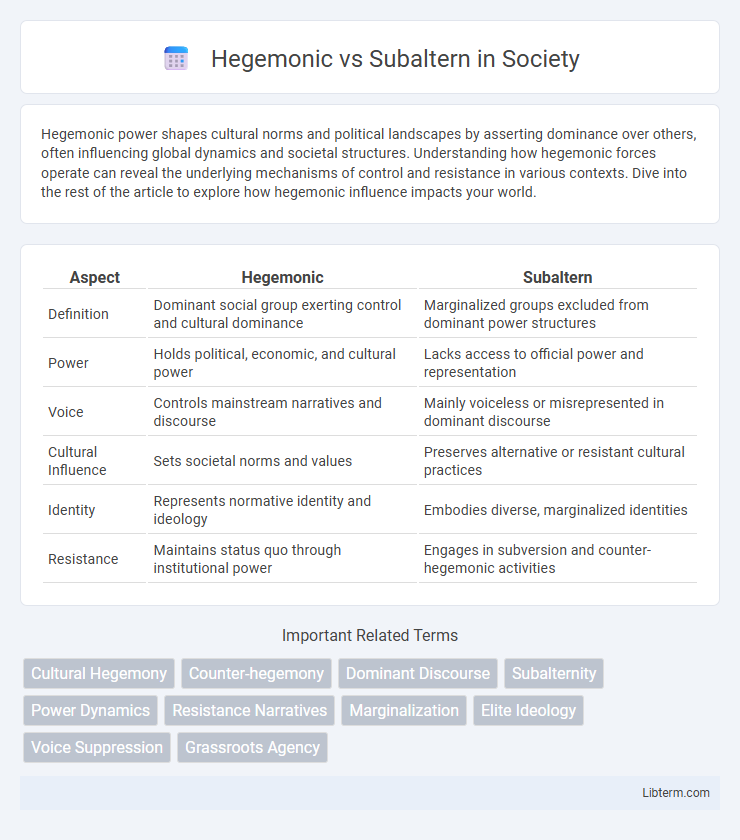Hegemonic power shapes cultural norms and political landscapes by asserting dominance over others, often influencing global dynamics and societal structures. Understanding how hegemonic forces operate can reveal the underlying mechanisms of control and resistance in various contexts. Dive into the rest of the article to explore how hegemonic influence impacts your world.
Table of Comparison
| Aspect | Hegemonic | Subaltern |
|---|---|---|
| Definition | Dominant social group exerting control and cultural dominance | Marginalized groups excluded from dominant power structures |
| Power | Holds political, economic, and cultural power | Lacks access to official power and representation |
| Voice | Controls mainstream narratives and discourse | Mainly voiceless or misrepresented in dominant discourse |
| Cultural Influence | Sets societal norms and values | Preserves alternative or resistant cultural practices |
| Identity | Represents normative identity and ideology | Embodies diverse, marginalized identities |
| Resistance | Maintains status quo through institutional power | Engages in subversion and counter-hegemonic activities |
Understanding Hegemony: Definition and Origins
Hegemony refers to the dominance of one group or ideology over others, shaping cultural norms, political power, and societal values through consent rather than force. Originating from Antonio Gramsci's theory, hegemony emphasizes how ruling classes maintain control by securing the active consent of subordinate groups, integrating their interests within dominant frameworks. Understanding hegemony reveals the intricate power dynamics that allow dominant ideologies to remain pervasive and unquestioned in social institutions.
Who are the Subaltern? Unpacking the Concept
Subaltern refers to populations marginalized within social, political, and economic hierarchies, often lacking a voice in hegemonic power structures. Originating from postcolonial theory, the term highlights groups such as peasants, indigenous peoples, and other oppressed communities excluded from elite discourse. Understanding subaltern identities involves examining how these groups resist domination and assert agency despite systemic invisibility.
Key Differences: Hegemonic vs Subaltern Perspectives
Hegemonic perspectives emphasize dominant power structures that shape cultural, political, and social norms, reinforcing the interests of ruling classes. Subaltern perspectives highlight marginalized groups excluded from mainstream discourse, focusing on their resistance and alternative narratives. Key differences lie in power dynamics, with hegemonic views maintaining status quo while subaltern viewpoints challenge and seek to destabilize it.
Historical Context of Hegemonic and Subaltern Groups
Hegemonic groups historically established dominance through political, economic, and cultural control, shaping societal norms and power structures across empires and nation-states. Subaltern groups, marginalized and excluded from mainstream discourse, resisted and challenged hegemonic authority, often preserving distinct identities and alternative narratives. The dynamic between hegemonic power and subaltern resistance has continuously influenced social hierarchies and historical developments worldwide.
Power Dynamics: How Hegemony Shapes Society
Hegemony represents the dominant power structure in society, where ruling groups maintain control through cultural, political, and economic influence rather than coercion. Subaltern groups exist on the margins, often marginalized and deprived of voice, struggling against the pervasive dominance of hegemonic norms. Power dynamics are thus defined by the hegemonic ability to shape social values, institutions, and knowledge, reinforcing systemic inequality and controlling societal narratives.
Voices from the Margins: The Subaltern Experience
The subaltern experience highlights marginalized voices excluded from dominant hegemonic narratives, emphasizing their unique perspectives and resistance against oppressive structures. Postcolonial theory explores how subaltern groups challenge hegemonic power by reclaiming agency through cultural expression and grassroots movements. Understanding these voices reveals the complexities of social hierarchies and the ongoing struggle for inclusion and representation.
Hegemonic Narratives in Media and Culture
Hegemonic narratives in media and culture dominate public discourse by reinforcing prevailing power structures and legitimizing dominant ideologies. These narratives shape social norms and identities through widespread representation in films, news, and literature, marginalizing alternative perspectives and subaltern voices. The persistence of hegemonic discourse limits pluralism, sustaining inequality by naturalizing the interests of ruling groups as universal truths.
Resistance and Agency: Subaltern Strategies
Subaltern strategies of resistance emphasize grassroots agency challenging hegemonic power structures through localized actions, cultural expressions, and everyday subversions. These tactics often bypass formal institutions, leveraging covert communication and communal solidarity to assert marginalized identities and demands. The dynamic interplay between hegemonic dominance and subaltern agency highlights resistance as a continuous, adaptive negotiation in socio-political contexts.
Impacts of Hegemonic and Subaltern Relations
Hegemonic relations reinforce dominant power structures by shaping cultural norms, political authority, and economic control, often marginalizing subaltern voices and limiting their agency. Subaltern groups challenge these hegemonies by creating alternative narratives and resistance strategies that expose inequalities and seek social transformation. The dynamic interplay between hegemonic dominance and subaltern resistance critically influences social hierarchies, identity formation, and political mobilization.
Rethinking Change: Towards Subaltern Empowerment
Rethinking change involves shifting focus from hegemonic power structures that dominate socio-political narratives to empowering subaltern groups by amplifying their voices and agency. Subaltern empowerment requires dismantling hierarchical systems and fostering inclusive spaces for marginalized identities to actively participate in decision-making processes. This transformative approach challenges traditional power dynamics and promotes social justice through grassroots mobilization and participatory democracy.
Hegemonic Infographic

 libterm.com
libterm.com